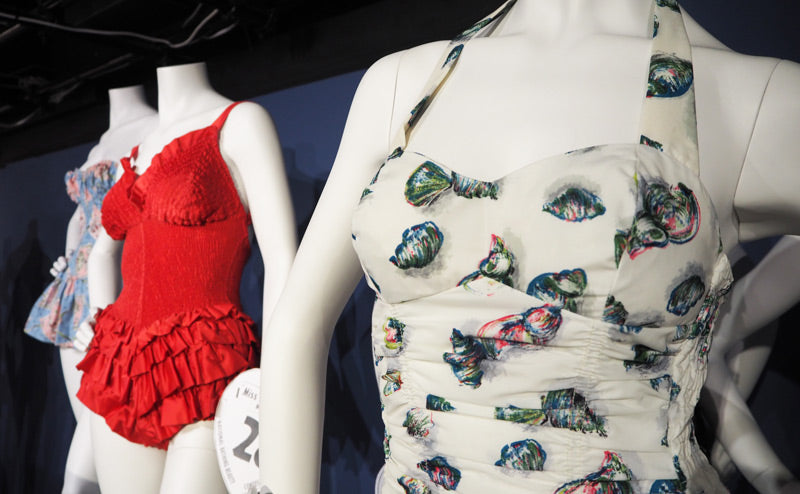If you're interested in the history of swim and beachwear then this exhibition is definitely one for you. Until the 13th September 2015, the Fashion & Textile Museum in London is displaying 'Riviera Style: Resort & Swimwear Since 1900', a collection of swimwear pieces and imagery of beachwear styles from years gone by. Last weekend I decided to take a trip down there to check out what was on show...

The exhibition is described as a celebration of "the rich array of clothing worn in and by the sea, and focuses on how clothing design, fabric and attitudes to exposing the body have changed since the late nineteenth century". It begins with the type of clothing that was seen in the early 1900s when women's bodies were completely covered for modesty. This included a bathing dress, bloomers, an over-dress, stockings, headgear and boots. This was generally made from wool and heavyweight cotton, not the coolest items of clothing to be wearing in the sun! It was also costly at this time to buy swimwear so many people couldn't swim in the sea and simply paddled in their everyday clothing. Swimwear was restricted to the more wealthy end of society at the start of the century.

By the 1920s and 1930s more skin was exposed at the beach and lidos due to the fashion for getting a suntan. It was also in the thirties that the Holidays with Pay Act gave people one week's annual paid holiday which increased the desire for resort wear. In the 1920s most swimwear was made from wool which was uncomfortable when wet, however by the 1930s new fabrics started to be developed. This included elastic-based threads with cotton, wool, silk or rayon yarn wound around to produce lastex. This gave two-way stretch meaning swimwear kept its shape better when wet. However as these were new fabrics, it tended to mean the swimwear was quite expensive.

In the 1940s not much swimwear was produced due to the war and people reverted to home made knitted swimwear if they need to. After the war in the 1950s the focus with swimwear was hugging the female figure with corset style cuts and built in support. Two pieces were seen more increasingly but for the most part women wore one-piece swimsuits with straight across cuts at the top and mid thigh level at the bottom. Nylon was also introduced which was lightweight and quick drying, perfect for swimwear! Also the ability to afford a holiday in the UK and abroad became more common so manufacturers began to make more brightly coloured swimwear and resort wear to suit the popularity of Continental holidays.

In the 1960s the bikini became widely worn and new fibres such as elastane hugely developed the fit and structure of swimwear. Pattern was also a huge part of the style in the sixties and seventies as prints were mostly psychedelic and in bright colours with matching resort wear. However a change came about in the 1980s with swimwear becoming much more revealing and mostly in single colours rather than prints. Plunging necklines, high cut legs and thongs were favoured in the eighties so fitness was much more important as the swimwear didn't provide much support or coverage.

Since the 1990s there have been many advances in the swim and resort wear industry. From a technical perspective there have been developments such as tan-through fabrics and speed enhancing fabrics. From a fashion perspective there is now much more of an emphasis on swimwear by top fashion houses and many of them produce collections. The advent of 'fast fashion' has also meant that swimwear trends can change much more rapidly and swimwear can be much more seasonal as it is available for all market levels. There has also been a return to body shaping materials and styles to suit all women and make them feel comfortable in swimwear.
It's definitely worth visiting the exhibition as it has a great range of swimwear to illustrate what it was like at different time periods to give you an idea of how far the swimwear world has come. There is also a wide array of vintage posters and imagery that really show how beach life used to be and puts it into great context. If swimwear is your thing then make sure you see it before it closes in September! There's also a lovely cafe to finish off your visit at the end, I would highly recommend the red velvet cookie!
You can find out more about the exhibition on their website. The Fashion & Textile Museum is located on Bermondsey Street and the nearest tube station in London Bridge. The exhibition costs £8.80 for adults, £6.60 for concessions and £5.50 for students.
